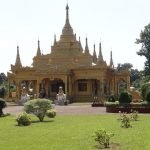A BLEEDING SHOULDER – INDIA’S NORTHEAST
The Kashmir insurgency having taken centre-stage for many years now, the insurgencies of the North-East no more occupy significant spaces of newsworthiness. Nevertheless, they are not dead as yet, lingering on preventing the region from going full steam on the road to development. This is an attempt to trace the histories of these insurgencies until 5 years ago when this study was undertaken. Nothing has changed drastically since then, with the insurgencies still existing or claiming to exist, with the formal burials yet to take place. Even the one notable development of the Government of India entering into a peace accord with NSCN (IM), the National Socialist Council of Nagaland (Isak-Muviah) in 2015, is yet to draw any dividends because the exact terms of the accord are yet to be made public and implemented. This is the seventh episode of a 9-blog series on the various ethnic insurgencies of the North-East, essentially meant to shed some light on this trouble-prone region’s problems, which large sections of ‘mainland Indians’ remain in the dark about even after nearly seven decades of the Republic taking shape.
7 Meghalaya – Testing the Waters
Meghalaya (meaning the ‘abode of clouds’), which attained statehood in January 1972, was carved out of Assam by joining the two districts of Khasi-Jhaintia Hills and Garo Hills, which were historically not parts of Assam, but separate tribal kingdoms, till the British made it so in the 19th Century. For the first two decades of its existence the state witnessed no insurgency. There has been an insurgency going on in the state for the last two decades which has been a comparatively low-intensity one (insurgency related fatalities in over two decades total 504). Having peaked early in the millennium it had been declining since, though the year 2012 showed a sudden spurt of violence).
The insurgency began as a combined movement of the tribal people in early 1990s against the ‘Dkhars’ or outsiders who were deemed to be exploiting them with an organization called the Hynniewtrep Achik Liberation Council (HALC) coming into being, the ‘Hynniewtrep’ representing the Khasi-Jhaintias and the ‘Achik’ representing the Garos. The two groups soon fell out with each other and in 1992 two separate outfits, the Hynniewtrep National Liberation Council (HNLC) and the Achik Matgric Liberation Army (AMLA), were formed. The Garo cause was subsequently taken over by the Achik National Volunteer Council (ANVC) formed in December 1995. The HNLC wanted the entire Meghalaya for Khasi-Jhainitias – to put down Garo dominance – while the ANVC wanted ‘Achik Land’, a separate homeland for Garos carved out of areas in Meghalaya as well as Assam, on the ‘Garo majority’ pretext. The fight now became as much inter-tribal in nature as against outsiders. Both the outfits were outlawed in November 2000.
[The frivolous disposition of these outfits is best illustrated by the story of the AMLA. Mooted in 1992 by some disgruntled Garo youth with active encouragement from NSCN-IM, the group launched itself on a fund raising spree in partnership with the cadres of the latter. They undertook a series of bank robberies. 70% of the booty went to the NSCN-IM towards service charges for the training imparted – the Garos had no experience of guerilla warfare – and the cost of arms and ammunition supplied. The AMLA cadres were soon disillusioned with the paltry 30% share they received as well as the hardship of a life on the run. They surrendered en masse to the security forces, having existed as an insurgent group for not more than three years.]Two more Garo outfits, the Liberation of Achik Elite Force (LAEF) and the Garo National Liberation Army (GNLA) came into existence in 2005 and 2009 respectively, the former demanding a separate state for Garos and the latter a ‘soveriegn Garoland’ itself. All these outfits have links with one or more of the major groups of the Northeast like one of the factions of NSCN, ULFA, NDFB or NLFT. The GNLA has been helping the ULFA cadres find an escape corridor to Bangladesh, with which Meghalaya shares border. Of the four main outfits, the ANVC alone has signed a ceasefire agreement – in July 2004 – with the Government of India.
While the insurgent activities in Meghalaya have never assumed the terrible proportions they have in most of the neighbouring states, the chances of escalation cannot be ruled out as the 2012 upsurge and the continuing spate of incidents indicates. Besides, normal life is invariably affected even if an insurgency is low-key with concomitant effects on economic development. Often the interference by political leaders with personal motives also plays a negative role. The governments, both state and central, seem to treat the issue rather complacently (some officials are believed to have dismissed the insurgents as just a ‘bunch of criminals’), instead of making an effort to address the problem. That kind of omission is bound to prove dear later.
[To be continued. Next: Arunachal Pradesh – A Disaster in Waiting]





